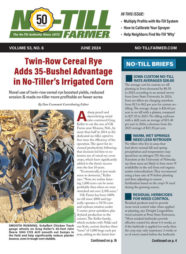By Extension Educator Jim Isleid
Many farms have experienced excessive rainfall and periods of saturated soil in 2017. Nitrogen fertilizer losses can be serious in fields where soils have been saturated for several days at a time.
University of Wisconsin Extension soil scientist and former Michigan State University Extension soil fertility specialist Carrie Laboski wrote an excellent article in 2008, “Potential for nitrogen loss from heavy rainfalls.” This information is applicable to the current growing season. She addresses the “million dollar question:” How much nitrogen loss should I expect from denitrification or leaching, and what should I do about it?
The following are a few key points from Laboski’s article. Nitrogen loss from heavy rainfall is most commonly due to denitrification and leaching.
Denitrification
- Nitrate must be present for denitrification to occur. Nitrogen losses will depend on the form of nitrogen applied and the period of time between fertilizer application and the beginning of saturated soil conditions.
- Denitrification occurs faster on warmer soils, especially over 75 degrees Fahrenheit.
- Denitrification is delayed by using urease inhibitors (applied with urea) and denitrification inhibitors. Injection of anhydrous ammonia increases soil pH temporarily, which limits the amount of ammonium converted to nitrate and delays denitrification.
- Farmers can estimate denitrification nitrogen losses using the tables and examples contained in Laboski’s article, or use a PSNT (pre-sidedress nitrate test) test for a more precise measurement of current soil nitrate availability.
- Denitrification is usually much worse on fine- or medium-textured soils than on coarse-textured soils due to the period of saturation.
Leaching
- Nitrate is the form of nitrogen when soils exceed their ability to hold water in the root zone.
- Leaching is a bigger problem on coarse-textured soils that hold 1 inch of water per foot, compared to less leaching trouble on finer-textured soils that hold 2.5–3 inches of water per foot.
- Leaching impact depends not only on the amount of rainfall, but also on the amount of nitrate present in the soil.
- Urea is highly water soluble. If excessive rainfall occurs within two to four days of application, the urea has not had time to convert to ammonium and is very vulnerable to leaching.
- Split application of nitrogen is a good practice to avoid excessive nitrogen loss from leaching.
Depending on crop growth stage and available equipment, crop nitrogen deficiencies can be corrected through irrigation, sidedressing with anhydrous ammonia, or sidedressing or broadcasting UAN or dry nitrogen fertilizer. Leaf burning from broadcast applications should be expected.
For details on estimating nitrogen loss from denitrification and leaching, review Laboski’s article, “Potential for nitrogen loss from heavy rainfalls.”
For more information on managing water- and storm-damaged fields from Michigan State University Extension:
- Repairing your flood-damaged fields
- Evaluating hail-damaged crops – Part 1
- Evaluating flood-damaged crops – Part 2
- Evaluating wind-damaged crops – Part 3
- Assessing water damage to emerged soybeans
- Resources to assist flood-impacted areas
This article was published by Michigan State University Extension. For more information, visit http://www.msue.msu.edu. To have a digest of information delivered straight to your email inbox, visit http://www.msue.msu.edu/newsletters. To contact an expert in your area, visit http://expert.msue.msu.edu, or call 888-MSUE4MI (888-678-3464).






Post a comment
Report Abusive Comment